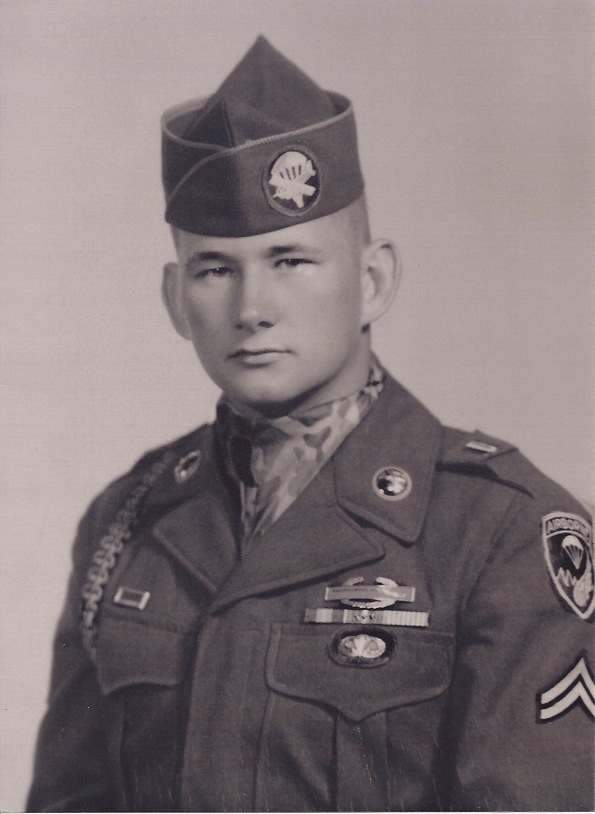Search Registry
Disclaimer: Information in the Registry is unofficial and not intended as a substitute for any official government record of military service.
Jerry Huntington |
|
| Born | 1934, Minneapolis, MN |
| Gender | Male |
| Parents | |
| Schools Attended | Minneapolis North HS |
| Branch of Service | Army Air Force |
| Additional Identifiers | Non-commissioned Officer National Guard Reserves |
| Service Timeframe | 1950 - 1991 * |
| War/Conflict | Korean War 1950-1953 |
| Principal Units and Locations | 151st Field Artillery; 187th Regimental Combat Team; 775th Quartermaster Company (Aerial Supply); 133rd Airlift Wing |
| Military Awards and Decorations | |
 Jerry Huntington as a member of the 187th Regimental Combat Team, 1953. | |
NarrativeJerry Huntington completed over 40 years of military service, much of it on Airborne status. In 1950, at the age of 16 and while attending Minneapolis North High School, he joined the 151st Field Artillery of the Minnesota Army National Guard. Unit drills were held in the Minneapolis downtown armory. Shortly after enlisting, the Korean War started and the 151st FA, part of Minnesota's 47th Infantry Division, was called to active duty and sent to Camp Rucker, Alabama, for training. Jerry liked the military and wanted to go with his unit, but he was too young to be federalized. When he turned 17 the following year, he persuaded his parents to sign papers authorizing him to enlist in the Regular Army. He wanted action and volunteered to “Go Airborne.” Following his advanced infantry training at Camp Breckenridge in Kentucky, he completed airborne training at Ft. Benning, Georgia. After a short leave at home, Huntington was sent to a much disorganized Camp Stoneman, California, prior to deployment overseas. He sailed on the USS Breckenridge, and after a ten-day layover in Okinawa, arrived in Korea where he was assigned to the 187th Regimental Combat Team (Rakkasans), an elite airborne unit. At this point in the war, both sides had settled into a style of trench warfare reminiscent of WWI with trenches, bunkers, combat outposts, active paroling and occasional major attacks to gain local or negotiating advantage. Huntington was assigned to a 57mm Recoilless Rifle team—a combat assignment—where he remained until the end of hostilities. The 187th was transferred to Japan in October 1953. Upon returning to the U.S. in August 1954, he was disappointed to be assigned to the non-airborne 10th Mountain Division at Ft. Riley Kansas. Huntington decided to leave the full-time Army. After being discharged from active duty, he rejoined his old unit, the Minnesota National Guard's 151st Field Artillery. From 1959-61, he served in "E" Company of the 135th Infantry Battle Group. He missed being “airborne,” however. In order to return to parachute jump status, he transferred to the Army Reserve's 775th Quartermaster Company (Aerial Supply). In this unit he received training as a parachute rigger, while making many parachute jumps and preparing and dropping all types of military equipment from the air. His hard work and mission dedication in the 775th earned him the rank of 1st Sergeant. Unfortunately, the 775th was re-designated and lost its jump status in 1971. Jerry took a reduction in rank to remain on jump status and transferred to the Minnesota Air National Guard. There he was able to serve in the 133rd Aerial Port and the 109th Tactical Airlift Squadron of the 133rd Airlift Wing, parachuting and rigging supplies for air drops. His last major deployment was for Operation Desert Storm in the winter of 1991. One of his last military jobs was to install new airfield landing lights at Camp Ripley. Jerry has long been a highly respected, strong supporter of Airborne veteran's organizations. He has also been a great friend of the Minnesota Military Museum and was instrumental in obtaining airborne and other artifacts for several museum exhibits and events. | |
